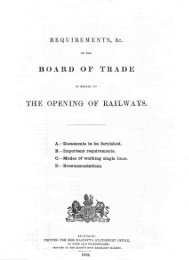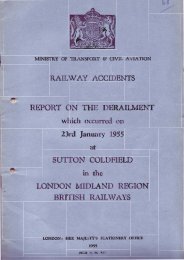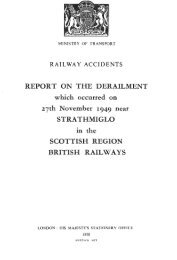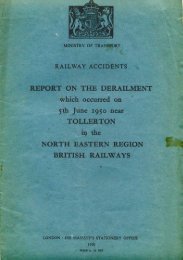R A I LT R AC K - The Railways Archive
R A I LT R AC K - The Railways Archive
R A I LT R AC K - The Railways Archive
Create successful ePaper yourself
Turn your PDF publications into a flip-book with our unique Google optimized e-Paper software.
Route characteristics<br />
DESCRIPTION This route predominantly carries passenger services operating<br />
along the coast as well as services that operate for a short distance and then turn<br />
north towards London.<br />
<strong>The</strong> route is almost entirely two track, although the short Ore–Appledore<br />
and Newhaven Harbour–Seaford sections are single track. Linespeed is<br />
Route vision<br />
Our vision is to improve linespeeds along the route so that, for the majority of<br />
journeys over 50 miles, rail has a journey-time advantage over road as well as<br />
significant environmental benefits. At the same time, freight connections will be<br />
improved in order to stimulate the freight market, although on this route there<br />
are a number of limitations.<br />
Journey times for both rail and road in this transport corridor are slower<br />
than for the routes from the coast to London. For rail this is due to both<br />
configuration and linespeeds. <strong>The</strong> configuration – two track with overtaking<br />
possible only at Lewes, Hove, Worthing and Barnham, and a length of single<br />
track with only one passing place at Rye – gives little opportunity for faster<br />
services. Linespeeds along this route are constrained by several factors<br />
including signalling, track curvature, 54 level crossings, the need for services to<br />
reverse at Brighton and Eastbourne and the substandard clearances in some<br />
of the eight tunnels.<br />
We, with a consortium of local authorities, funded a preliminary study of<br />
the line between Weymouth and Dover, comprising this route as well as parts of<br />
Routes 6 and 21. This report identified a large number of improvements which, if<br />
all were implemented, would improve the fastest journey time from Weymouth<br />
to Dover by 37% at an estimated cost of between £300M and £500M. Lower-<br />
Route development and customer requirements<br />
At Eastbourne, Phase 2 of the SRP is well under way which will see extensive<br />
repairs to this listed station. At Lewes, the local authority has resolved to grant<br />
listed-building consent for major refurbishment, and construction works will begin<br />
this year including rebuilding part of Platform 1 and providing new toilet<br />
predominantly 75mph with notable exceptions being 90mph from Southerham<br />
Junction to Willingdon Junction and 60mph from St Leonard’s Warrior Square to<br />
Ashford. Apart from the Ore–Ashford section, the route is electrified.<br />
Capacity on some parts of the route is constrained by the lack of<br />
passing places.<br />
cost improvements that provide journey-time savings were also identified. <strong>The</strong><br />
report concluded that, even when measures designed to reduce demand for car<br />
travel were considered, insufficient passengers would be attracted to the route to<br />
fund the infrastructure improvements. This scheme also needs to be assessed<br />
against other proposed transport schemes in this corridor.<br />
We are wo rking with the Gove rnment Office for the South East to agree<br />
h ow the benefits to the wider community of the altern a t i ve rail and road schemes<br />
can be assessed. This assessment will then be used to agree whether there is<br />
scope to progress a rail scheme. <strong>The</strong> current timing of the multimodal study fo r<br />
this corridor means that it is unlike ly that any decision will be reached in the next<br />
three ye a rs. We support the position of other stake h o l d e rs that this mu l t i m o d a l<br />
study should be brought forward in order that a decision be reached far more<br />
q u i c k ly. In part i c u l a r, we note that the South East Regional Planning Confe r e n c e<br />
has identified the South Coast Corridor as one of the fi ve areas or corri d o rs in<br />
the whole of the South East of England considered to be of regional signifi c a n c e.<br />
It is our determination that the Ore–Ashford section will be electrified,<br />
although there is still a funding gap to be overcome. <strong>The</strong> timing will be heavily<br />
dependent on issues relating to the life of the current rolling stock.<br />
accommodation. At Hastings, planning permission is being sought for a<br />
multimillion-pound scheme to construct a new station building and refurbish<br />
platform facilities. Included within the proposals is an improved public<br />
transport interchange .<br />
239








